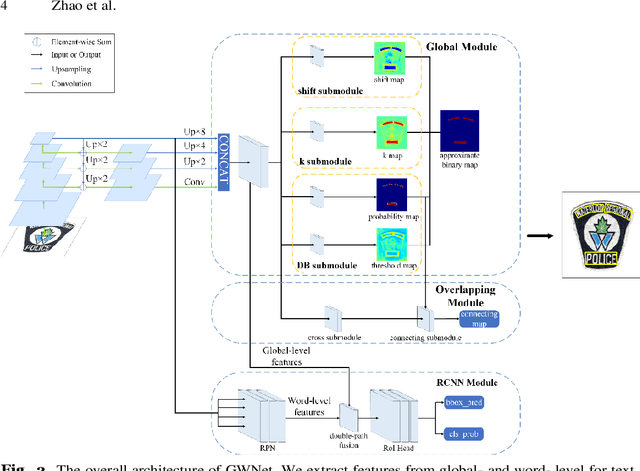Xue Xu
Empowering Backbone Models for Visual Text Generation with Input Granularity Control and Glyph-Aware Training
Oct 06, 2024Abstract:Diffusion-based text-to-image models have demonstrated impressive achievements in diversity and aesthetics but struggle to generate images with legible visual texts. Existing backbone models have limitations such as misspelling, failing to generate texts, and lack of support for Chinese text, but their development shows promising potential. In this paper, we propose a series of methods, aiming to empower backbone models to generate visual texts in English and Chinese. We first conduct a preliminary study revealing that Byte Pair Encoding (BPE) tokenization and the insufficient learning of cross-attention modules restrict the performance of the backbone models. Based on these observations, we make the following improvements: (1) We design a mixed granularity input strategy to provide more suitable text representations; (2) We propose to augment the conventional training objective with three glyph-aware training losses, which enhance the learning of cross-attention modules and encourage the model to focus on visual texts. Through experiments, we demonstrate that our methods can effectively empower backbone models to generate semantic relevant, aesthetically appealing, and accurate visual text images, while maintaining their fundamental image generation quality.
UNIMO-G: Unified Image Generation through Multimodal Conditional Diffusion
Jan 25, 2024Abstract:Existing text-to-image diffusion models primarily generate images from text prompts. However, the inherent conciseness of textual descriptions poses challenges in faithfully synthesizing images with intricate details, such as specific entities or scenes. This paper presents UNIMO-G, a simple multimodal conditional diffusion framework that operates on multimodal prompts with interleaved textual and visual inputs, which demonstrates a unified ability for both text-driven and subject-driven image generation. UNIMO-G comprises two core components: a Multimodal Large Language Model (MLLM) for encoding multimodal prompts, and a conditional denoising diffusion network for generating images based on the encoded multimodal input. We leverage a two-stage training strategy to effectively train the framework: firstly pre-training on large-scale text-image pairs to develop conditional image generation capabilities, and then instruction tuning with multimodal prompts to achieve unified image generation proficiency. A well-designed data processing pipeline involving language grounding and image segmentation is employed to construct multi-modal prompts. UNIMO-G excels in both text-to-image generation and zero-shot subject-driven synthesis, and is notably effective in generating high-fidelity images from complex multimodal prompts involving multiple image entities.
UPainting: Unified Text-to-Image Diffusion Generation with Cross-modal Guidance
Nov 03, 2022



Abstract:Diffusion generative models have recently greatly improved the power of text-conditioned image generation. Existing image generation models mainly include text conditional diffusion model and cross-modal guided diffusion model, which are good at small scene image generation and complex scene image generation respectively. In this work, we propose a simple yet effective approach, namely UPainting, to unify simple and complex scene image generation, as shown in Figure 1. Based on architecture improvements and diverse guidance schedules, UPainting effectively integrates cross-modal guidance from a pretrained image-text matching model into a text conditional diffusion model that utilizes a pretrained Transformer language model as the text encoder. Our key findings is that combining the power of large-scale Transformer language model in understanding language and image-text matching model in capturing cross-modal semantics and style, is effective to improve sample fidelity and image-text alignment of image generation. In this way, UPainting has a more general image generation capability, which can generate images of both simple and complex scenes more effectively. To comprehensively compare text-to-image models, we further create a more general benchmark, UniBench, with well-written Chinese and English prompts in both simple and complex scenes. We compare UPainting with recent models and find that UPainting greatly outperforms other models in terms of caption similarity and image fidelity in both simple and complex scenes. UPainting project page \url{https://upainting.github.io/}.
Real-time Scene Text Detection Based on Global Level and Word Level Features
Mar 10, 2022



Abstract:It is an extremely challenging task to detect arbitrary shape text in natural scenes on high accuracy and efficiency. In this paper, we propose a scene text detection framework, namely GWNet, which mainly includes two modules: Global module and RCNN module. Specifically, Global module improves the adaptive performance of the DB (Differentiable Binarization) module by adding k submodule and shift submodule. Two submodules enhance the adaptability of amplifying factor k, accelerate the convergence of models and help to produce more accurate detection results. RCNN module fuses global-level and word-level features. The word-level label is generated by obtaining the minimum axis-aligned rectangle boxes of the shrunk polygon. In the inference period, GWNet only uses global-level features to output simple polygon detections. Experiments on four benchmark datasets, including the MSRA-TD500, Total-Text, ICDAR2015 and CTW-1500, demonstrate that our GWNet outperforms the state-of-the-art detectors. Specifically, with a backbone of ResNet-50, we achieve an F-measure of 88.6% on MSRA- TD500, 87.9% on Total-Text, 89.2% on ICDAR2015 and 87.5% on CTW-1500.
 Add to Chrome
Add to Chrome Add to Firefox
Add to Firefox Add to Edge
Add to Edge